“Motion class 9 Short Notes Chapter 7, Easy And Keyword Focused!” is prepared from the NCERT text book. All the questions in your examinations are framed on the basis of this book.
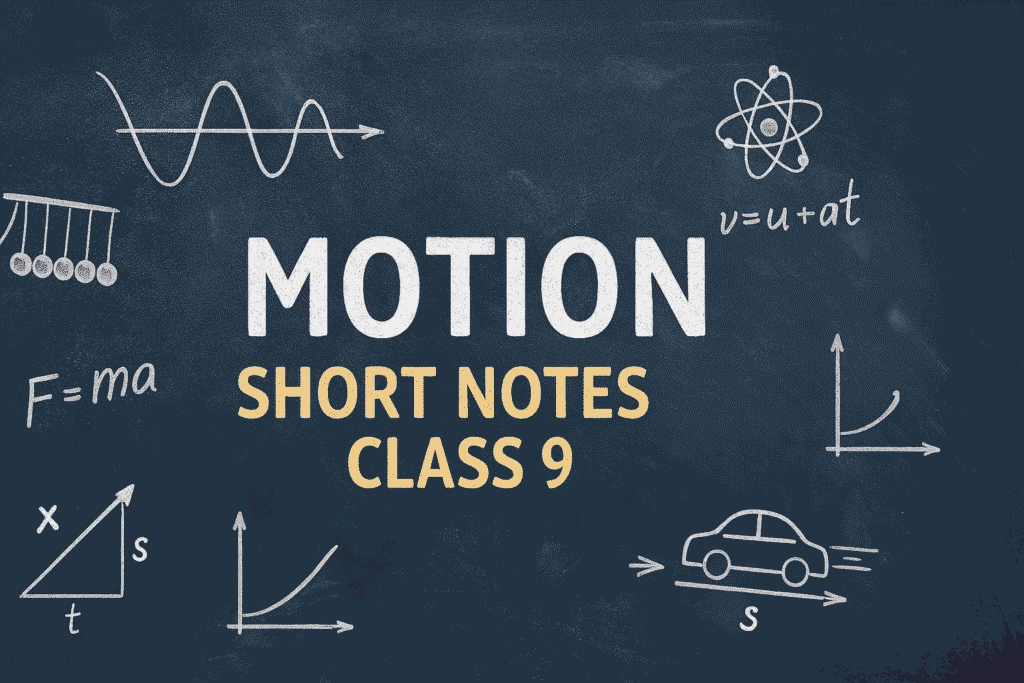
Table of Contents
MOTION: Fundamental Concepts
- Definition of Motion: We often perceive an object to be in motion when its position changes with time.
- Motion can also be inferred through indirect evidences (e.g., motion of air by observing dust or leaves).
- Relativity of Motion: An object may appear to be moving for one person and stationary for another (e.g., roadside trees appear to move backwards for bus passengers, while a person on the road sees the bus moving).
- Types of Motion: Most motions are complex. Some common types include:
- Straight line motion.
- Circular path motion.
- Rotation.
- Vibration.
- Situations can involve a combination of these.
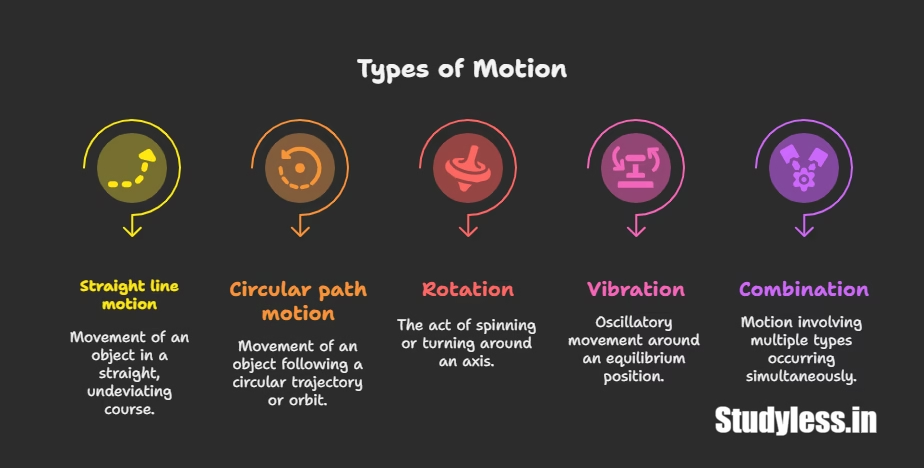
Describing Motion
- Reference Point/Origin: To describe the location or position of an object, we must specify a reference point, also called the origin.
- Example: A school is 2 km north of the railway station, making the railway station the reference point.
- Motion Along a Straight Line: This is the simplest type of motion.
Distance and Displacement
- Distance:
- The total path length covered by the object.
- To describe distance, we need to specify only its numerical value (magnitude).
- Magnitude: The numerical value of a physical quantity.
- Example: An object moving from O to A (60 km) and then to C (35 km from A) covers a total distance of 60 km + 35 km = 95 km.
- An odometer in automobiles shows the distance travelled.
- Displacement:
- The shortest distance measured from the initial to the final position of an object.
- The magnitude of displacement can be equal to or less than the distance travelled.
- Zero Displacement: The magnitude of displacement can be zero even if the corresponding distance covered is not zero.
- Example: If an object travels from O to A (60 km) and then back to O, the final position coincides with the initial position, so the displacement is zero, but the distance covered is 120 km (60 km + 60 km).
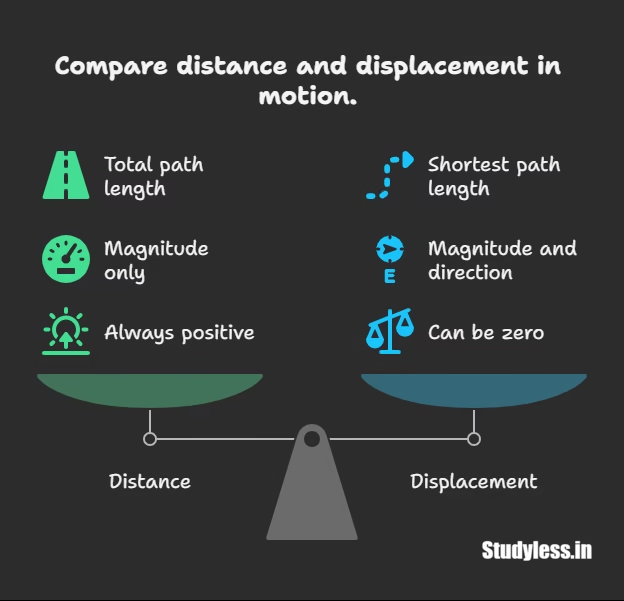
Uniform and Non-Uniform Motion
- Uniform Motion: An object is in uniform motion if it covers equal distances in equal intervals of time. The time interval should be small.
- Velocity: During uniform motion along a straight line, the velocity remains constant with time. The change in velocity is zero.
- Non-Uniform Motion: Objects are in non-uniform motion when they cover unequal distances in equal intervals of time.
- Examples: A car on a crowded street or a person jogging in a park.
- Velocity: In non-uniform motion, velocity varies with time and has different values at different instants and points.
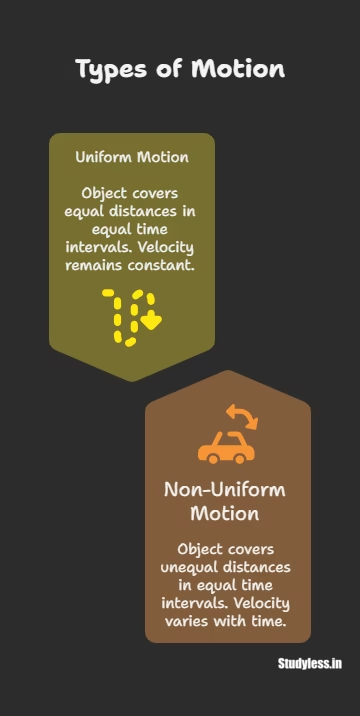
Measuring the Rate of Motion: Speed and Velocity
- Speed:
- The distance travelled by the object in unit time.
- To specify speed, only its magnitude is required.
- SI Unit: metre per second (m s⁻¹ or m/s).
- Other units: centimetre per second (cm s⁻¹) and kilometre per hour (km h⁻¹).
- Average Speed: Used when objects are in non-uniform motion.
- Formula: Average speed = Total distance travelled / Total time taken v = s / t
- Example: Car travels 100 km in 2 h, average speed is 50 km h⁻¹.
- Velocity:
- The speed of an object moving in a definite direction.
- Specifies both speed and its direction of motion.
- Can be uniform or variable.
- Can be changed by changing the object’s speed, direction of motion, or both.
- SI Unit: m s⁻¹ or m/s (same as speed).
- Average Velocity:
- For an object moving along a straight line at a variable speed, it’s calculated similar to average speed.
- If the velocity of the object is changing at a uniform rate, average velocity is the arithmetic mean of initial velocity and final velocity.
- Formula: Average velocity = (initial velocity + final velocity) / 2
- v_av = (u + v) / 2
- Distinction between Speed and Velocity: Speed requires only magnitude, while velocity specifies both magnitude (speed) and direction. Average speed and average velocity can be different (e.g., Usha swimming 180 m in a 90 m pool and returning to start: average speed = 3 m/s, average velocity = 0 m/s).
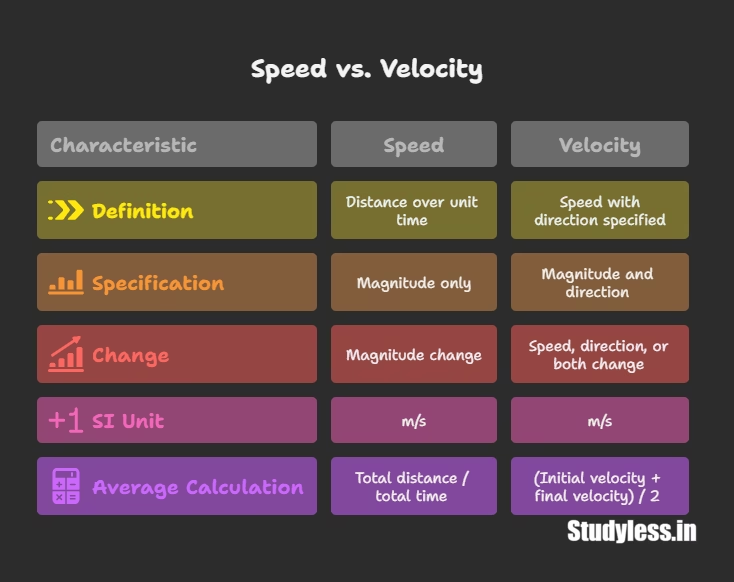
Acceleration : Rate of Change of Velocity
- Acceleration:
- A measure of the change in the velocity of an object per unit time.
- Formula: acceleration = change in velocity / time taken a = (v – u) / t (where u = initial velocity, v = final velocity, t = time)
- SI Unit: m s⁻².
- Direction: Taken as positive if in the direction of velocity, and negative when opposite to the direction of velocity.
- Accelerated Motion: Motion where velocity changes.
- Uniform Acceleration: An object travels in a straight line, and its velocity increases or decreases by equal amounts in equal intervals of time.
- Example: Motion of a freely falling body.
- Non-Uniform Acceleration: Velocity changes at a non-uniform rate.
- Example: A car on a straight road increasing its speed by unequal amounts in equal time intervals.
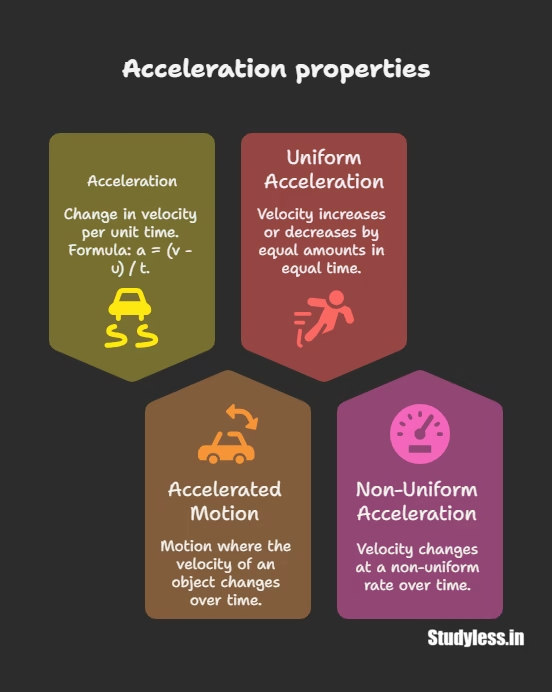
Graphical Representation of Motion
- Purpose: Graphs provide a convenient method to present basic information and show the dependence of one physical quantity (like distance or velocity) on another (like time).
- Axes: Time is taken along the x-axis, and distance or velocity is taken along the y-axis.
Distance-Time Graphs
- Uniform Speed: The graph of distance travelled against time is a straight line. This shows distance is directly proportional to time. (Fig. 7.3)
- Determining Speed: The speed (v) of an object from a distance-time graph is calculated as the slope of the line: v = (s₂ – s₁) / (t₂ – t₁)
- Non-Uniform Speed (Accelerated Motion): The distance-time graph shows a non-linear variation of distance with time. The shape is different from uniform motion. (Fig. 7.4)
- Object at Rest: A distance-time graph that is a straight line parallel to the time axis indicates that the object is at rest (not moving).
Velocity-Time Graphs
- Uniform Velocity: The velocity-time graph is a straight line parallel to the x-axis (time axis). (Fig. 7.5)
- Displacement (Magnitude) from Velocity-Time Graph: The area enclosed by the velocity-time graph and the time axis is equal to the magnitude of the displacement (distance moved).
- For uniform velocity: s = Area of rectangle (velocity × time interval).
- Uniformly Accelerated Motion: The velocity-time graph is a straight line. (Fig. 7.6)
- The area under this graph (e.g., a trapezoid or rectangle + triangle) gives the distance (magnitude of displacement).
- s = Area ABCDE = Area of rectangle ABCD + Area of triangle ADE = (AB × BC) + ½ (AD × DE)
- The area under this graph (e.g., a trapezoid or rectangle + triangle) gives the distance (magnitude of displacement).
- Non-Uniformly Accelerated Motion: Velocity-time graphs can have any shape. (Fig. 7.7)
Equations of Motion (for Uniform Acceleration)
- For an object moving along a straight line with uniform acceleration, three equations relate its velocity, acceleration, distance, and time.
- Variables:
- u: Initial velocity.
- v: Final velocity.
- a: Uniform acceleration.
- t: Time.
- s: Distance travelled.
- Equations:
- Velocity-time relation: v = u + at
- Position-time relation: s = ut + ½ at²
- Position-velocity relation: 2as = v² – u²
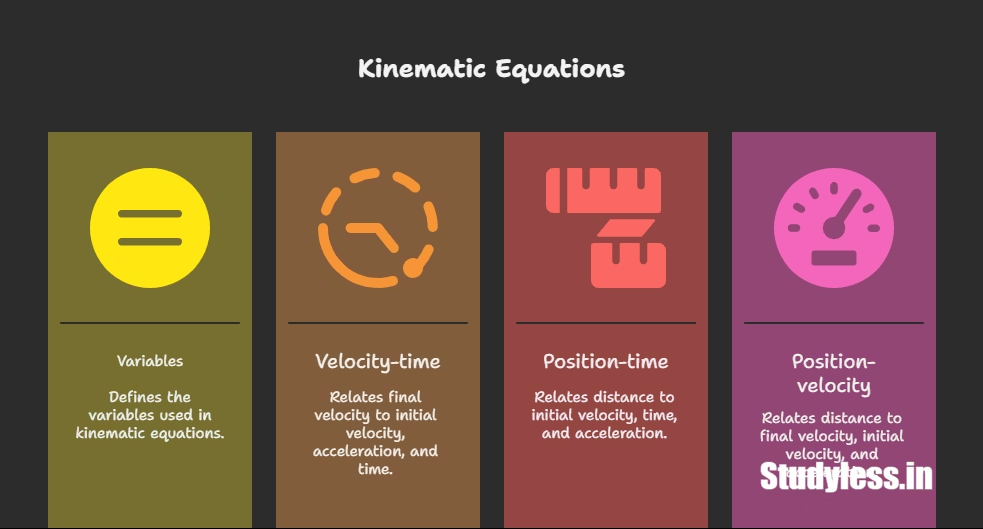
Uniform Circular Motion
- Acceleration in Circular Motion: When an object moves along a circular path with constant magnitude of velocity (uniform speed), its direction of motion changes continuously. This continuous change in direction means the object is accelerating.
- Uniform Circular Motion: Occurs when an object moves in a circular path with uniform speed.
- Speed Formula for Circular Path: If an object takes t seconds to go once around a circular path of radius r, its speed v is given by: v = 2πr / t
- 2πr is the circumference of the circle.
- Examples: Athlete throwing a hammer/discus, motion of the moon and the Earth, a satellite in a circular orbit, a cyclist on a circular track at constant speed.
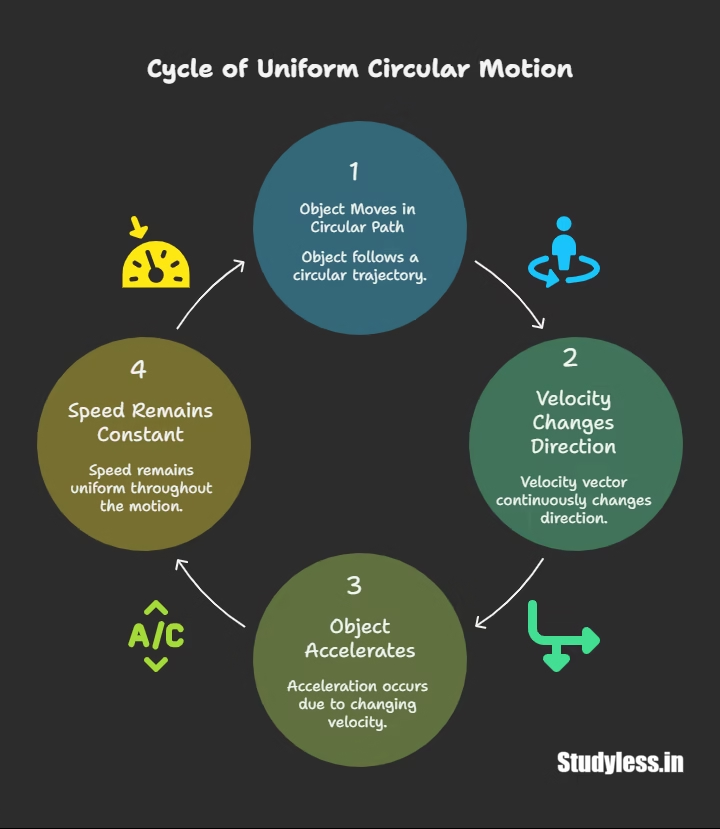
2 responses to “Motion class 9 Short Notes Chapter 7, Easy And Keyword Focused!”

It is very much helpful for my studies tis website is the best to pass exam

Thanks! Any Other Feedback?


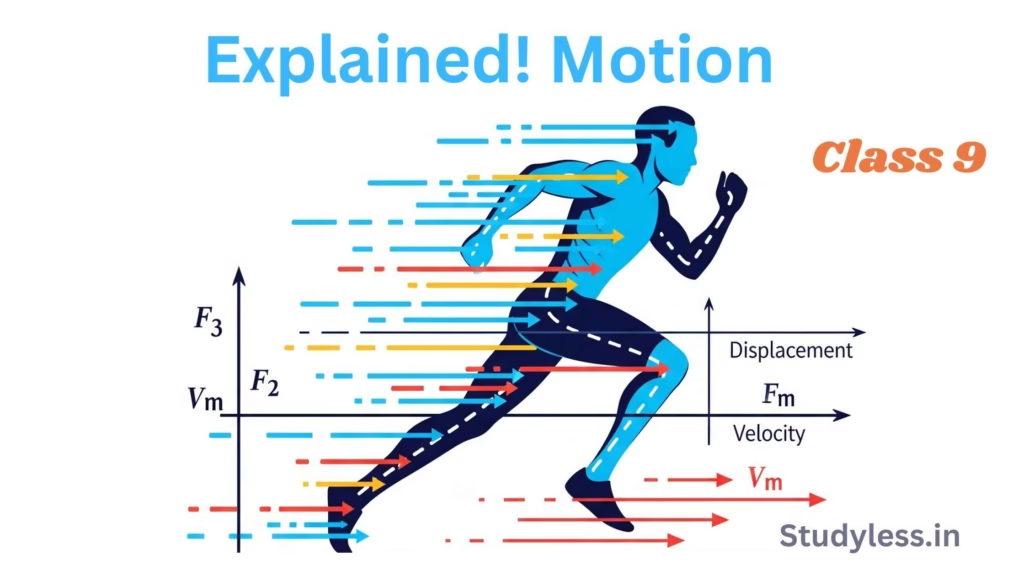
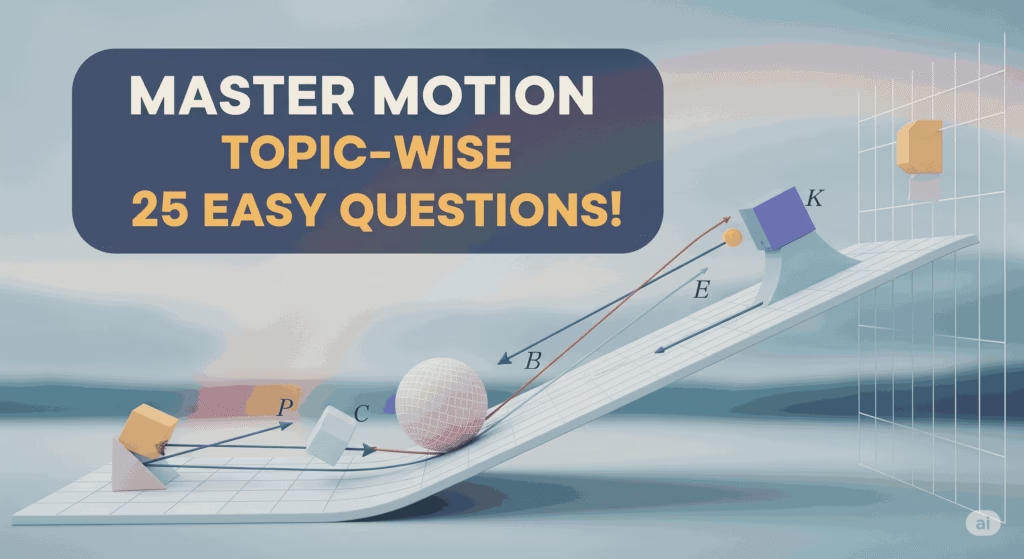

Leave a Comment